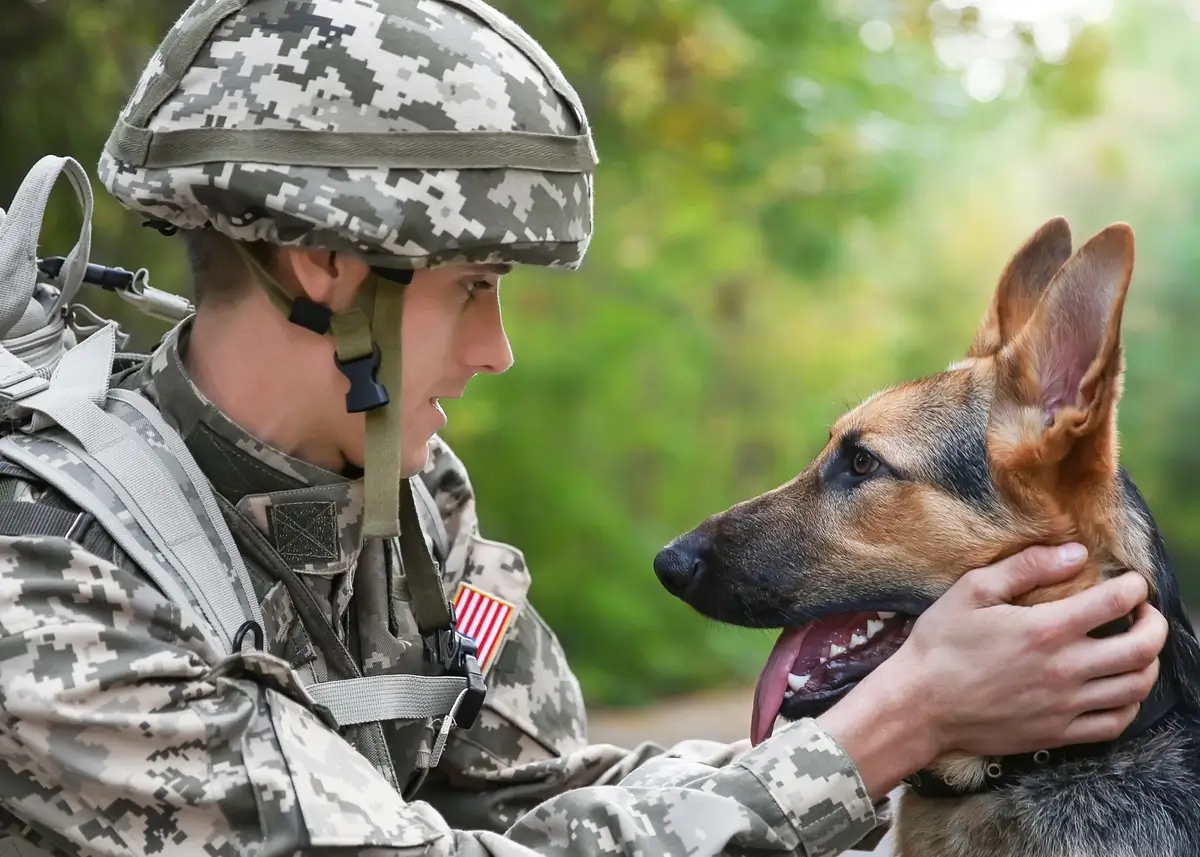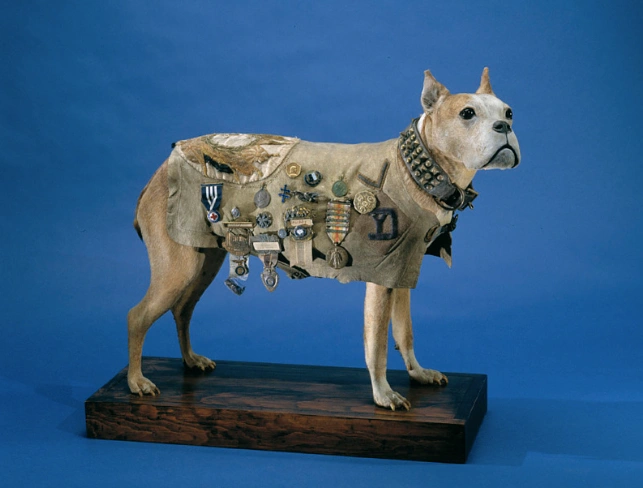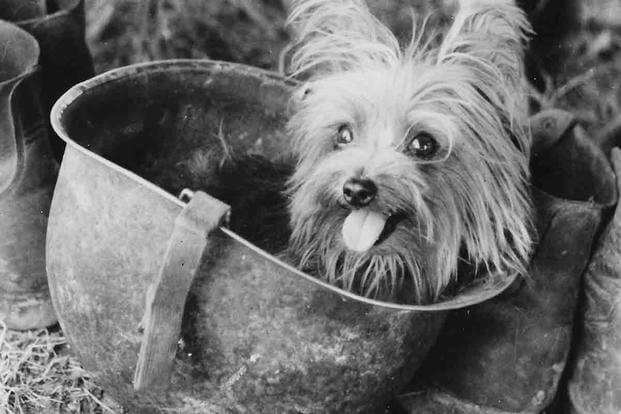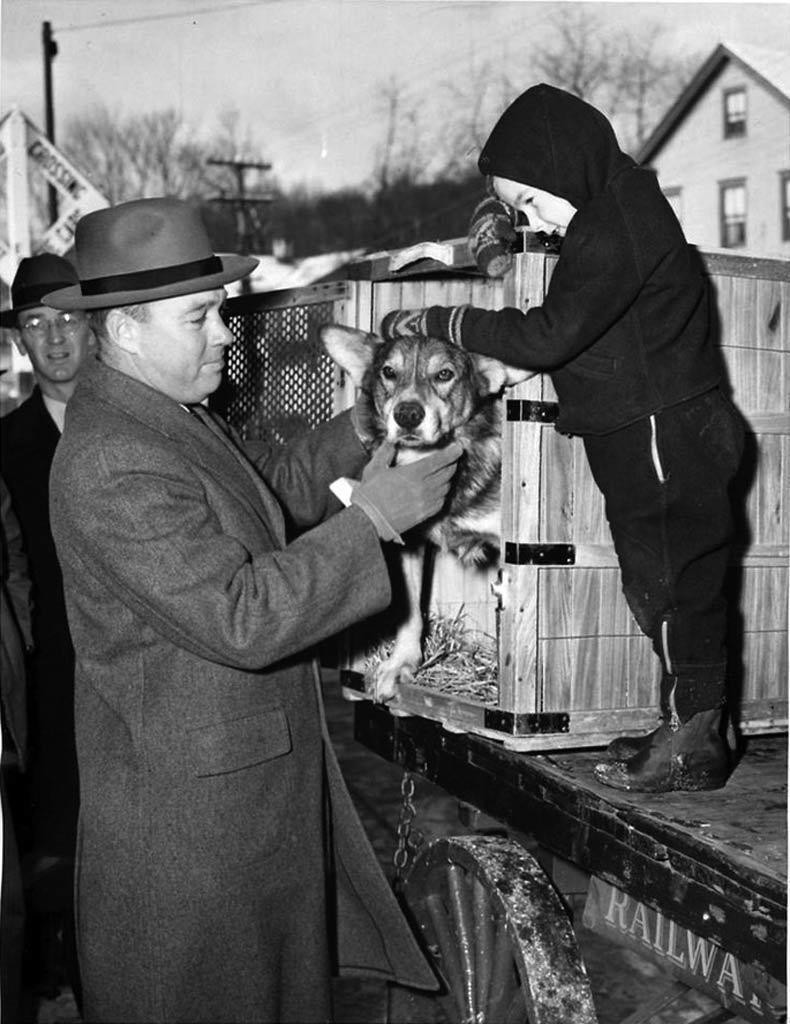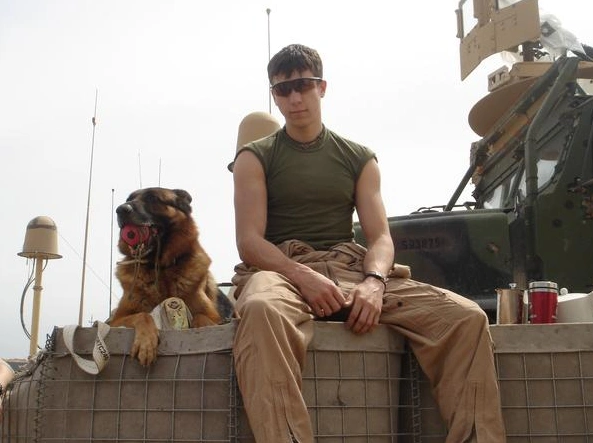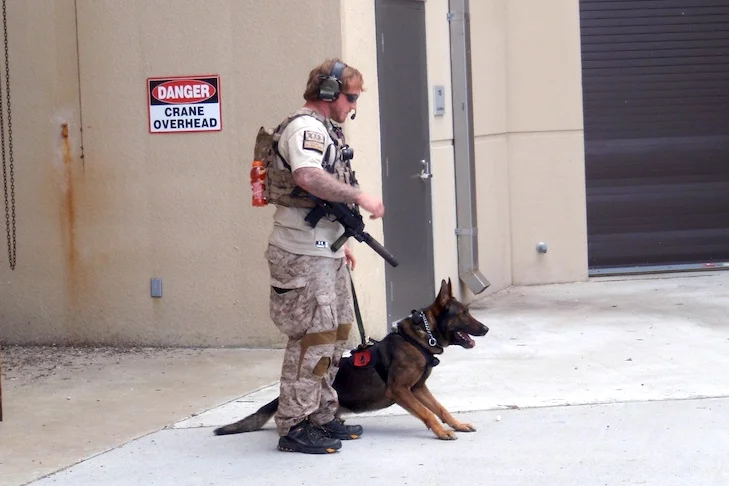Would you trust your best friend with your life? How about your canine best friend?
Man’s best friend is good for a cuddle session and a romp at the park for civilian life, but dogs trained for war can do more than follow basic commands – they can become our nation’s heroes with their brave acts of valor. Highly trained military dogs have saved countless lives throughout various wars and conflicts going back to ancient times.
We may assume canine war heroes have all been Doberman Pinschers, German Shepherds, or Belgian Malinois, but even the tiniest of Yorkshire Terriers can be of service.
To fully appreciate war hero dogs, it’s important to examine the history of United States military working dogs, understand their training process, and meet some famous war dogs that have changed history one paw at a time.
Why Dogs For War Training?
Qualities we admire in dogs are also those that make them great soldiers. The strong bonds they form with us, their eagerness to please, innate work drive, the ability to learn and perform hundreds of commands, their energetic nature, incredible sense of smell, unending loyalty, and fearless attitude as protectors and guardians make canines a perfect animal choice for an animal to fight alongside humans in war situations.
When out in the field, a handler and dog must be able to read subtle body movements and facial expressions to communicate the task at hand without drawing attention from the enemy. A fortified bond allows seamless communication to perform tasks that even humans would not be able to do.
Military dogs are invaluable to military operations. Whether over rugged terrain or jumping out of helicopters, military working dogs are used to extreme conditions they overcome to perform certain specialized tasks. Some military working dog tasks they are trained to do include:
- Guard/sentry for protection
- Search and rescue
- Identifying explosives
- Securing locations
- Detecting drugs
- Tracking and locating enemies
- Attacking enemy forces
- Retrieving objects and information
Military working dogs can even hold ranks just like humans do. The ranks aren’t official, but the dog ranks one higher than the handler as a form of respect for the canine companion.
Battle of Bougainville, 1943. Courtesy of Getty Images
History of Official US Military Working Dogs
Countless dogs throughout history have aided soldiers in their pursuit of glory and defeat, but World War I was the first official war where dogs in Germany and England were trained specifically to assist war efforts. Canines called “mercy dogs” would help the Red Cross locate and care for wounded soldiers in the field. They also served as messengers and sentry duty.
The US began training military dogs for World War II to prevent and mitigate threats. In 1943, the War Dog Program began at Front Royal in Virginia, and seven war dog platoons resulted from the Camp Lejeune branch of the program. These dogs were trained to be messenger, infantry, and sentry dogs suited to operate in the lush vegetation of the Pacific arena. Around 75% of dogs used during combat were Doberman Pinschers, with 25% German Shepherds completing the military dog roster. World War II dogs were trained not to bark when they detected enemies up to half a mile away among other amazing feats to assist Allied forces.
In subsequent years, the War Dog Program would grow into a success. In 1967, the Air Force Security Police Dog Training School began at Lackland Air Force Base and grew into what is now known as the DoD Military Working Dog School, where thousands of dogs have been trained as fearless warriors with around 2,300 dogs currently serving.
For most of the 20th century, Military Working Dogs (MWDs) were considered surplus equipment and were euthanized after retiring from service, even if there was nothing wrong with their health, performance, or temperament. After the Vietnam War, hundreds of service dogs were discarded, deemed not useful anymore, and abandoned or euthanized even though military dogs were credited for saving over 10,000 lives in the Vietnam War.
Modern-day War Dogs
Today, the thought that MWDs should automatically be euthanized no longer exists thanks to Robby’s Law. Signed in 2000, Robby’s Law requires the military to report where the dogs end up after their service, whether it’s through adoption, law enforcement, or euthanasia only under appropriate circumstances. If adopted, the dogs cannot return to their military posts. Instead, they can live out the rest of their lives with law enforcement, private citizens, and most importantly, the handlers who work alongside them.
Every branch of service utilizes MWDs. The 341st Training Squadron at Joint Base San Antonio is now the location of the Military Working Dog Breeding Program, where 50-90 Belgian Malinois are born, bred, and trained specifically for military work. The military also procures suitable puppies from elite breeders. After they spend their first year becoming socialized as normal puppies and also as future warriors, the young dogs must pass the 120-day training program successfully to begin life as Military Working Dogs. From there, they are sent to various branches across the world to help serve and protect the US in various ways.
5 Famous Military Working Dogs
While entire films and books have been produced filling the screen and pages with incredible feats of noble war dogs, a few in particular stand out as an introductory collection of famous military working dogs.
Stubby is on display at the Smithsonian's National Museum of American History
1. Sergeant Stubby the World War I Hero
Stubby, a mutt resembling a Pitbull/Boston Terrier/Bulldog mix, wandered into a training session of the 102nd Infantry at Yale University in 1917, thus beginning his war career. Eventually, Corporal James Robert Conroy smuggled Stubby onto a ship and was allowed to stay after Stubby saluted the commanding officer.
Stubby would go on to serve critical missions with the 26th Yankee Division as the 102nd Infantry’s mascot. He learned to detect mustard gas and incoming artillery, comforted the wounded, and even singlehandedly captured a German spy.
Stubby became an overnight war hero, met three presidents, marched in parades, appeared on the Silver Screen, and participated in all sorts of fanfare. He is the most decorated war dog of WWI and was promoted to sergeant through his combat efforts. His remains and taxidermy mount are on display at the Smithsonian National Museum of American History.
Smoky the War Dog courtesy of William A. Wynne/Smoky War Dog LLC
2. Smoky the Yorkshire Terrier
One of the most famous World War II war hero dogs is Smoky the Yorkshire Terrier. She is credited with being the world’s first therapy dog for wounded soldiers as well as a personal pet and canine combat veteran. While living in New Guinea, Smoky was separated from her original owner, field nurse Grace Guderian, and ended up in a foxhole miles away in the care of Bill Wynne. Wynne taught Smoky over 200 tricks, and Smoky became the mascot of the troops and a frequent visitor to the field hospital, cheering up wounded soldiers. Smoky even won a mascot contest, earning the title of “Champion Mascot in the Southwest Pacific Area" by Yank Magazine, photographed sitting in Wynne’s helmet.
One of the most famous feats of Smoky is when she ran wire in an 8-inch pipe to the other side of a culvert to protect a crucial taxiway. There was no other way human soldiers could accomplish this task, but highly trained Smoky was the perfect size to squeeze through openings barely four inches across. Despite a setback with a snagged wire, Smoky successfully allowed communications of secret codes to resume.
Soldiers were certainly not allowed to travel back home with animals, but Wynne snuck Smoky in his oxygen equipment, where Smoky continued to entertain veterans and delight people with her funny dog tricks as a civilian pet. She lived a fascinating life and passed away at the old age of 14 having served her country well.
Chips returns to the Wren family after his honorable discharge (photo courtesy of Spc. Caitlin Wilkins)
3. Chips the WWII Sentry Dog
Another famous dog to aid in WWII efforts was Chip, a Collie/Malamute/German Shepherd mix. Chips was a civilian dog belonging to the Wren family who enrolled in the Dogs for Defense program at the War Dog Training Center in Front Royal, VA to learn how to be a duty dog, a decision that proved monumental to the Roosevelt-Churchill Conference of 1943. While under attack from Italian soldiers, Chips jumped into the enemy’s pillbox, seriously attacking the soldiers and causing them (and 10 others) to surrender as prisoners.
Chips was the dog hero of the 3rd Infantry Division in 1942 through his discharge in December 1945, serving on several campaigns in Algeria, Morocco, Sicily, Tunisia, and the Rhine and Central Europe, some under General Patton.
Chips was awarded the Purple Heart, the Silver Star, the Distinguished Service Cross, and battle stars for each campaign, all of which were later revoked because of the Army’s policy that dogs were considered equipment and not worthy of awards. However, Chips went on to receive the PDSA Dicken Medal posthumously in 2018 and the Animals in War & Peace Medal of Bravery in 2019.
Lex and Marine Corporal Lee in Iraq
4. Lex the German Shepherd
Lex the German Shepherd is a remarkable canine hero who is a true testament to the devotion a military dog shares with his handler. Marine Corporal Dustin J. Lee had signed up to serve his country in Iraq after the 9/11 attacks and was so gifted with dogs that he was put in charge of two of them, one of them being Lex, an explosives detection dog. They instantly formed a strong bond and worked together on various missions.
Tragically, Corporal Lee and Lex were attacked by a 73 mm SPG-9 rocket, fatally injuring Corporal Lee and causing extensive wounds to Lex. When help arrived, Lex refused to leave Lee’s side and had to be dragged away so medics could assist the situation. His mobility suffered due to his extensive injuries with over 50 pieces of shrapnel embedded in his body, and he could not continue as a military working dog. Lee’s family petitioned the US Government to allow Lex to live with them. Lex was the first active duty military working dog to receive an early retirement and lived with Lee’s family, receiving a commemorative Purple Heart for his valiant service.
Cairo the Belgian Malinois and his handler, Will Chesney (courtesy of Will Chesney)
5. Cairo the Belgian Malinois
Navy SEAL Will Chesney met Cairo, the Belgian Malinois who would become his partner and best friend in 2008 and served their first deployment to Afghanistan together in 2009. Cairo became instrumental in secret missions, including two to retrieve missing Sergeant Bowe Bergdahl but was wounded in the line of duty. After recovering, Cairo was called to carry out one of the most instrumental missions the US Navy SEALS has ever achieved – finding Osama bin Laden.
Cairo served his unit by finding hidden enemies, staying right by Chesney’s side as he battled PTSD and traumatic brain injury. In 2011, Cairo helped secure the perimeter of the compound where Bin Laden and his people were hiding during the secretive SEAL Team Six mission that killed bin Laden as the only canine involved, ending a reign of terror. To Cairo though, it was just another mission accomplished.
Cairo retired and Chesney was able to adopt him, where Cairo served as a support and therapy dog while Chesney suffered from severe PTSD. Unfortunately, Cairo passed away from cancer only a year after Chesney left the service but not before saving one more life – Chesney’s. “I owe him so much,” said Chesney about Cairo’s legacy.
Work With a Dog From Pawrade
If you are inspired by the utter devotion and diligent nature of military working dogs, you may be considering a dog with the same qualities as a pet. You may be wondering where to find puppies for sale from reputable breeders that will become your very own hero. That’s where Pawrade answers the call.
At Pawrade, we take our duty very seriously to provide a scam-free adoption platform where you don’t have to worry about whether or not your puppy is from a trustworthy breeder. Through our partnership with pre-screened, hand-selected breeders and a secure platform transaction management system, we make adopting puppies easy and seamless. Let us help you find your own canine hero.
